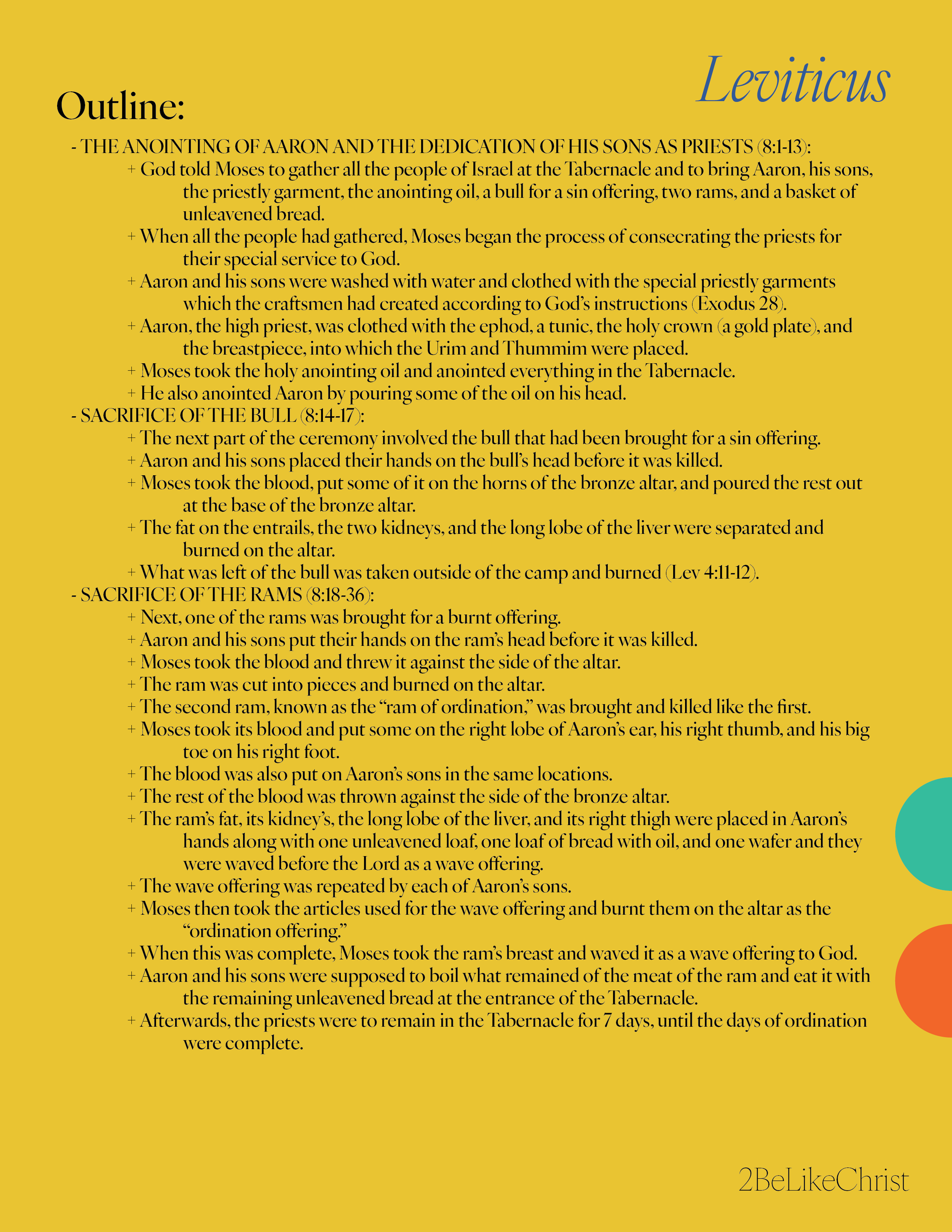Leviticus 8 Summary: A Short Breakdown in 5 Minutes
Leviticus 8 Summary - A Quick Overview
WHEN:
Leviticus picks up where Exodus left off. The children of Israel are on their way through the wilderness to the Canaan land.
According to Leviticus 8, the Tabernacle had already been erected, which would place the year at approximately 1490 B.C. (one year after the Israelites left Egypt).
DEFINITIONS:
Urim and Thummim – The Urim and Thummim were carried inside the breastpeice of the high priest. The exact nature of these object is unknown, the Bible doesn’t provide us with details. It appears they were used by the priests to determine the will of God (Numbers 27:21).
Aaron’s Sons – Aaron had 4 sons who served under him as priests. Their names were Nadab, Abihu, Eleazar, and Ithamar (Exodus 28:1).
TABERNACLE DIAGRAM
OUTLINE:
THE ANOINTING OF AARON AND THE DEDICATION OF HIS SONS AS PRIESTS (8:1-13):
God told Moses to gather all the people of Israel at the Tabernacle and to bring Aaron, his sons, the priestly garment, the anointing oil, a bull for a sin offering, two rams, and a basket of unleavened bread.
When all the people had gathered, Moses began the process of consecrating the priests for their special service to God.
Aaron and his sons were washed with water and clothed with the special priestly garments which the craftsmen had created according to God’s instructions (Exodus 28).
Aaron, the high priest, was clothed with the ephod, a tunic, the holy crown (a gold plate), and the breastpiece, into which the Urim and Thummim were placed.
Moses took the holy anointing oil and anointed everything in the Tabernacle.
He also anointed Aaron by pouring some of the oil on his head.
SACRIFICE OF THE BULL (8:14-17):
The next part of the ceremony involved the bull that had been brought for a sin offering.
Aaron and his sons placed their hands on the bull’s head before it was killed.
Moses took the blood, put some of it on the horns of the bronze altar, and poured the rest out at the base of the bronze altar.
The fat on the entrails, the two kidneys, and the long lobe of the liver were separated and burned on the altar.
What was left of the bull was taken outside of the camp and burned (Lev 4:11-12).
SACRIFICE OF THE RAMS (8:18-36):
Next, one of the rams was brought for a burnt offering.
Aaron and his sons put their hands on the ram’s head before it was killed.
Moses took the blood and threw it against the side of the altar.
The ram was cut into pieces and burned on the altar.
The second ram, known as the “ram of ordination,” was brought and killed like the first.
Moses took its blood and put some on the right lobe of Aaron’s ear, his right thumb, and his big toe on his right foot.
The blood was also put on Aaron’s sons in the same locations.
The rest of the blood was thrown against the side of the bronze altar.
The ram’s fat, its kidney’s, the long lobe of the liver, and its right thigh were placed in Aaron’s hands along with one unleavened loaf, one loaf of bread with oil, and one wafer and they were waved before the Lord as a wave offering.
The wave offering was repeated by each of Aaron’s sons.
Moses then took the articles used for the wave offering and burnt them on the altar as the “ordination offering.”
When this was complete, Moses took the ram’s breast and waved it as a wave offering to God.
Aaron and his sons were supposed to boil what remained of the meat of the ram and eat it with the remaining unleavened bread at the entrance of the Tabernacle.
Afterwards, the priests were to remain in the Tabernacle for 7 days, until the days of ordination were complete.
APPLICATION:
It’s clear that being a priest was a serious job.
Priests who didn’t take their job seriously were sometimes killed by God (Lev 8:35; Lev 10).
In the New Testament, disciples of Jesus are called to a special role as priests.
1 Peter 2:9 - But you are a chosen race, a royal priesthood, a holy nation, a people for his own possession, that you may proclaim the excellencies of him who called you out of darkness into his marvelous light.
Are we taking this role seriously?
Do our lives reflect our special calling? Are we striving for holiness in our manner of living?
Can we truthfully say our lives are dedicated to the service of God?
Becoming a Christian is a commitment to continually sacrifice your will and your life to God.
That repeated daily offering is part of how we worship today.
We don’t offer a lambs or oxen as worship; our worship is the presentation of our bodies as living sacrifices (Rom 12:1).
Is that your daily goal?


